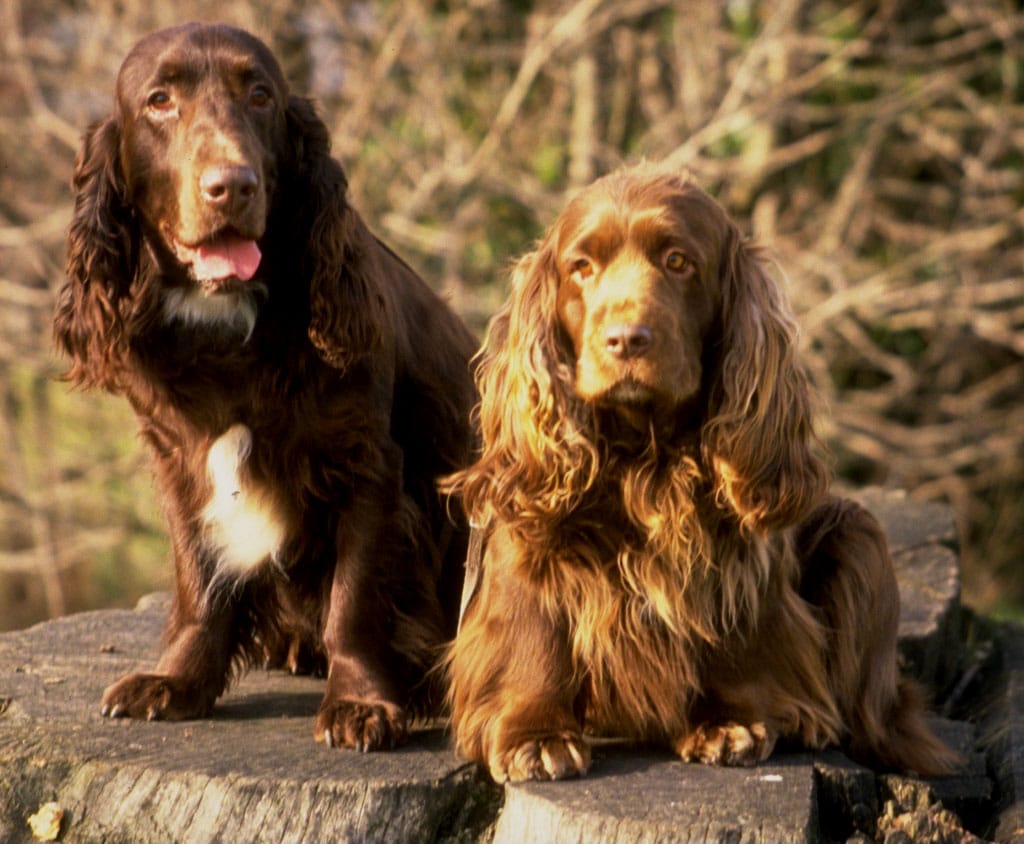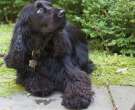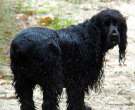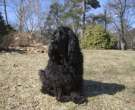Content |
|---|
Characteristics "Field Spaniel"
Coexistence is important that you have with your new friend. Before considering the acquisition of a dog of the breed "Field Spaniel" you know certain factors. Not all breeds of dogs are apt to live in an apartment, you must take into account his character, their need for exercise, their interaction with other pets, their care and if you have small children, their level of tolerance towards them.
Adaptation ⓘ5.0 out of 5 stars (based on 1 review)
|
friendly dog ⓘ5.0 out of 5 stars (based on 1 review)
|
hair loss ⓘ3.0 out of 5 stars (based on 1 review)
|
|---|---|---|
Affection level ⓘ5.0 out of 5 stars (based on 1 review)
|
Need for exercise ⓘ5.0 out of 5 stars (based on 1 review)
|
Social need ⓘ4.0 out of 5 stars (based on 1 review)
|
Home ⓘ4.0 out of 5 stars (based on 1 review)
|
Toilet ⓘ3.0 out of 5 stars (based on 1 review)
|
Friendly with strangers ⓘ3.0 out of 5 stars (based on 1 review)
|
barking ⓘ3.0 out of 5 stars (based on 1 review)
|
Health ⓘ4.0 out of 5 stars (based on 1 review)
|
Territorial ⓘ2.0 out of 5 stars (based on 1 review)
|
Cat friendly ⓘ3.0 out of 5 stars (based on 1 review)
|
Intelligence ⓘ5.0 out of 5 stars (based on 1 review)
|
Versatility ⓘ5.0 out of 5 stars (based on 1 review)
|
Child friendly ⓘ5.0 out of 5 stars (based on 1 review)
|
Surveillance ⓘ3.0 out of 5 stars (based on 1 review)
|
joy ⓘ5.0 out of 5 stars (based on 1 review)
|
History
The Field Spaniel (Field) is an example of what can go wrong when trying to breed sporting dogs for their looks without considering their use in the field. In the early days of the breed, in the XVIII century, the Spaniels were defined by their size, and it was considered Field Spaniel to any dog ​​that weighed more than 11 kg (25 pounds). The Spaniels smaller ones were known as “Cockers”, and both sizes could be born in the same litter. His fur used to be liver, liver and white, red, Red and white, yellow or black and white.
The advent of dog shows in the mid-19th century motivated dog breeders to start considering both appearance and function.. The different was good. Thus was born the “Black Spaniel”. That was good, but unfortunately the dogs that were long and short – as the “Sussex Spaniel“- they were popular at dog shows at the time. The breeders began to cross Field Spaniel with “Sussex Spaniels“. How the size of the dogs was so different, the results were disastrous, converting to Field into a heavy, unattractive dog who could barely move. Even so, exaggerated-looking dogs won at shows.
Finally, people came to their senses and the fashion of Field Spaniel finished. Dogs could have gone extinct, but they were revitalized after World War I through crosses with the “English Springer Spaniel”, that were more suitable for the size of the Field Spaniel. Through careful breeding, their usefulness as hunting dogs was restored, with the ability to break through the undergrowth that was too difficult for the “Springer”, and the speed they lacked the “Sussex” and the “Clumber“.
The breed was not yet saved. World War II put an end to breeding, and then only a few good dogs were left. In United States, there was no Field Spaniel until the age of 60. The Field Spaniel Society of America was formed in 1978. Dogs are still little known today, but they are no longer in danger of extinction. The Field Spaniel ranks 132 between breeds registered by the AKC.
Physical characteristics
The Field Spaniel is closely related to the Cocker Spaniel and the “English Springer Spaniel”. In the beginning, the three races were separated mainly by size. With a weight range of 15 to 22 Kg, the Field Spaniel is bigger than him “Cocker” but smaller than the “Springer“. In addition to hunting, competes in field tests and uses his excellent nose in tracking tests. It is a rare breed, but if you are looking for a solid hunter in addition to a family companion, the Field Spaniel is one of those you should consider.
Weight and size:
Females have an approximate size of 43 cm., While the males measure approximately 45 cm.. Its approximate weight varies from 18 – 25 kg.
Character and skills
The Field Spaniel has the typical features of Spaniel: sensitivity, affection for his family and willingness to learn. With strangers, is reserved, even shy if not well socialized, but their owners will experience a playful and mischievous side. It can be a barker when it shows joy or restlessness.
Its medium size and docile character can make it a good choice for families with children.. He also gets along well with pets, as cats, if he grew up with them. But, pet birds may need to watch their tail. Even though i don't hunt, the Field Spaniel he will take every opportunity to hunt birds and will do his best to go after them. Unless you are in an area with no traffic, keep it on a leash or you'll lose it in the chase.
The Field Spaniel is a dog that needs a job. He is not the type of dog that spends the day eating cookies. Take a daily leash walk of at least an hour, take him to safe, traffic-free areas where he can run off-leash and sign him up for dog sports like agility, obedience, rally and crawl.
Education
The Field Spaniel is intelligent and accepts training well. Like most Spaniels, has a mild temperament and responds best to positive reinforcement techniques, like the compliments, the game and the food rewards. Tends to mature slowly, so you must be patient and constant. In the field he has a natural tendency to explore, that can be stopped by teaching commands like “Venz”, “Wait” and “stay”.
Start training your puppy the day you bring him home. Even at eight weeks old, is able to absorb everything that can be taught. Don't wait for you to have 6 months to start training or you will have to deal with a stubborn dog. If possible, take him to a kennel school for puppies when he is between 10 and 12 weeks, and socializes.
Health
All dogs have the potential to develop genetic health problems, like all people have the potential to inherit diseases. Avoid any breeder that does not offer a health guarantee for the puppies, to tell you that the breed has no known problems or to keep puppies isolated from the main part of the house for health reasons. A reputable breeder will be honest and open about breed health problems and the incidence with which they occur.
The Field Spaniel They have some health conditions that may be of concern, especially if you are not cautious with breeder selection. Among them are the Hypothyroidism and eye problems such as cataract, progressive retinal atrophy and retinal dysplasia.
Do not buy a puppy from a breeder who cannot provide you with written documentation that the parents have been exempted from health issues affecting the breed. Make the dogs are “reviewed by the veterinarian” not a substitute for genetic health testing.
Careful breeders screen their breeding dogs for genetic diseases and breed only the healthiest and best-looking dogs, but sometimes mother nature has other ideas. A puppy can develop one of these diseases despite good husbandry practices. Advances in veterinary medicine mean that, In most cases, dogs can still have a good life. If you are getting a puppy, ask the breeder about the ages of the dogs in their lines and what are the most common causes of death.
Remember that after welcoming a new puppy into your home, you have the power to protect you from one of the most common health problems: the obesity. Keeping the dog at an adequate weight is one of the easiest ways to extend its life. Take advantage of your prevention skills to ensure a healthier dog for life.
Grooming
The Field Spaniel has only one coat, that is to say, does not have undercoat. Silky hair is moderately long and can be straight or slightly wavy. The front of the chest, the belly, the back of the legs and the rear are fringed like those seen in breeds “Setter”.
The coat is not heavy and it is easy to maintain. You have to brush it weekly and comb its fringes a couple of times a week, or whenever the dog has been outside or has twigs or other debris stuck to the hair. Trim the hair between the paw pads and inside the ears. Bathe the dog only when necessary; regular brushing should keep it pretty clean. The Field Spaniel they molt moderately.
If you plan to expose your Field Spaniel, ask the breeder for advice on how to present the dog at a dog show. You must have a natural look, but may need a little more razor cleaning, scissors and grooming blades of what a pet dog would receive.
The rest is basic care. Trim nails as needed, usually every few weeks. Yes to your Field Spaniel he likes to swim - and even if he doesn't like- keep hanging ears clean and dry to avoid bacterial or fungal infections. Brush your teeth frequently for general good health and fresh breath.
Images "Field Spaniel"
Photos:
1 – Field Spaniel by Peter, CC BY 2.0, via Wikimedia Commons
2 – A Grupp 8: FIELD SPANIEL, Winterbourne Itsy Bitsy Spider by Swedish fair
3 – My dog, Lily, after enjoying a smelly romp through a fetid swamp close to home. what a plague. Lily is a Field Spaniel. by Jo-Anna Ghadban, CC BY 2.0, via Wikimedia Commons
4 – Daisy – Field Spaniel by Peter, CC BY 2.0, via Wikimedia Commons
5 – Field Spaniel In Liver Color by RishiBali, CC BY-SA 3.0, via Wikimedia Commons
6 – Field Spaniel The Westminster Kennel Club 137th Annual All Breed Dog Show February 11-12, 2013 New York, NY by Andrea Arden
Videos "Field Spaniel"
Type and recognitions:
- FCI CLASSIFICATION: 123
- Group 8: Retrievers - Flushing Dogs - Water Dogs
- Section 2: Flushing Dogs. With working trial.
Federations:
- – FCI – Group 8: Retrievers - Flushing Dogs - Water Dogs – Section 2: Retrievers ⓘ
- – AKC – Sporting ⓘ
- – ANKC – Group 3 (Gundogs) ⓘ
- – CKC – Sporting Dogs ⓘ
- – KC – Gundog ⓘ
- – NZKC – Gundog ⓘ
- – UKC – Gun Dogs ⓘ
FCI breed standard "Field Spaniel"
Alternative names:
1. Field (English).
2. Field (French).
3. Field (German).
4. Field (Portuguese).
5. Field, Spaniel de campo (español).











